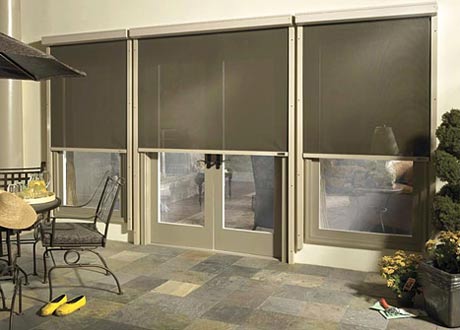
Image Credit: northsolarscreen.com
If yesterday’s forecast was correct, today may be the hottest day of the year for much of New England—with temperatures rising into the mid-90s. This may not draw much sympathy from friends in Austin, Texas where today’s temperature may rise to 100 in this unusually hot summer, or in Phoenix, where it’s projected to warm up to 107 (well below the season high of 116), but for southern Vermont, the mid-90s is pretty hot.
There are lots of things we can do to keep reasonably cool during hot weather. The easiest—but most expensive—is to turn on an air conditioner, which uses electricity (a lot of it) to cool down a space and remove moisture. There are other strategies that use a lot less energy, though they require some thought and common sense.
The first priority should be to keep unwanted heat out of the house. This means closing windows during the hottest part of the day and using blinds, awnings, or other devices to keep direct sunlight out of windows—especially on the east and west side of a house.
It seems counter-intuitive to close windows when it’s hot out. Don’t we want those breezes through the house? Breezes are great (more on that below), but if the air blowing in from outside is 10 degrees warmer than the air in your house, you’re likely to decrease, rather than increase, comfort. During hot weather, we close our house up during the day and open it up at night. It’s amazing how much difference that makes—though with a poorly insulated house it will make less difference, because more heat will enter through the walls and roof.
As for keeping sunlight out, it’s best if you can block sunlight before it actually gets through your window—i.e., providing exterior shade in some way. Trees, vines, and other vegetation work really well for shading a house, though they also block views. Europeans are fond of exterior roller shades, which are highly effective, but rare here. If those aren’t options, interior blinds work reasonably well—especially if the outer surface is fairly reflective.
Another important strategy is to limit your use of heat-producing lights, appliances, and other equipment during the day. If you need electric light, use compact fluorescent lamps (CFLs) instead of incandescent light bulbs, which convert 90 percent of the electricity into heat, only 10 percent into light. Try to avoid too much cooking on hot days—summer is a great time to grill outdoors and eat more salads. Run your dishwasher at night. Turn off stereo equipment and televisions with a power strip when not in use—so you know the equipment is really off and not generating heat (and wasting electricity). In an office, turn off computer monitors and copiers when it’s not being used—unless equipment has an energy-saving “standby” mode.
It may seem too obvious to warrant mentioning, but wear light clothing. Shorts, loose-fitting shirts, blouses, and dresses allow more air circulation next to your skin and will keep you cooler. Engineers actually have a measure for the insulating value of clothing and it’s impact on comfort—the “Clo” rating—that they use for modeling interior comfort conditions in buildings (a Clo of 0 corresponds to no clothing, and Clo of 1.0 for a business suit, with Clo values of different items of clothing additive). In a work environment, convince management to relax dress standards during hot weather and keep the air conditioning set point higher.
Finally, use fans to keep air moving. Moving air evaporates moisture from our skin and keeps us cooler. A ceiling (paddle) fan works great, but portable fans—the kind that can be set to oscillate—can be even more effective, because you can direct the air flow to exactly where it’s needed. Note that these fans don’t actually cool the air in a room; what they do is raise your “comfort window” (the temperature at which you’ll be reasonably comfortable).
Air flow can raise your comfort temperature by 5 degrees, or even more, so that if you’re normally comfortable at 73 degrees in still air, you could be just as comfortable at 78 or even 80 degrees. Turn off fans when you leave a room, since the fans use electricity and actually warm the room slightly from the motor’s waste heat. Window fans that are installed in an open window are best for use at night; during the day you’ll be bringing hot air in from outside.
In the long run, it’s a great idea to improve the insulation levels and air tightness of your home. A highly insulated, tight house is much easier to keep cool on hot days. If you do use a standard air conditioner, the better insulated the house, the less work the air conditioner will have to do to maintain comfort. And if you don’t air condition, the better insulated the house, the more effectively these other measures will work.
Weekly Newsletter
Get building science and energy efficiency advice, plus special offers, in your inbox.















One Comment
Weatherization lowers AC usage
Good tips Alex,
We did quite a thorough air sealing and insulation upgrade to our Minneapolis house several years ago and in doing so lowered the heating and cooling load substantially. For folks interested in energy upgrades for their homes, I would recommend improving the building envelope first and then sizing the HVAC equipment with the improved building efficiency in mind. Properly sized equipment gives the highest efficiency and in the case of AC, proper dehumidification.
The highest return on investment came from the building envelope improvements even though we replaced 1978 vintage HVAC equipment with state of the art high efficiency units.
Log in or create an account to post a comment.
Sign up Log in